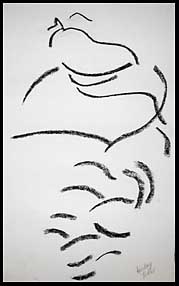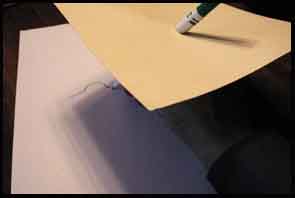 this method this method
|
Learning to Draw
by
making it easier for the right brain
and harder for the
left brain
|
If you are new to
the split brain theory, you will find a good explanation in Drawing
on the Right Side of the Brain by Betty Edwards.
Most libraries have it or you can order a copy.
TEACHER
TECHNIQUES TO MAKE IT Easy
FOR THE RIGHT BRAIN
For many people, left brain thinking tries to dominate. It has all the remembered drawings and symbols and the right brain is so overpowered that it fails to see much.
An important prior assumption: Many teachers assume that "making it easy" consists of showing kids exactly what to do. They will draw something in front of the kids and ask them to follow along in a step-be-step fashion. Yes, this is easy for the kids. If this is your method, you may want to skip this page, because you may not like what I say here.
I believe the neurons that imitate and copy are different from the neurons that actually think, imagine, transform what we see, materialize what we see, interpret what we see, and so on. The copy neurons are like our mirror neurons. Our mirror neurons operate instinctively and help us do all kinds of imitation what we see without consciously thinking. However, we are producing substantially different neurons when we have to move an observation through our brain in order to purposely move the hand based a real thing rather simply repeating another picture. This is harder to do than copying a picture. Therefore, the points below are offered in order to make it easier to get new neurons to develop (not just to get another nice drawing on a piece of paper). The goal seeing better and drawing better because the brain has learned to process what is seen in the real world. Most of these points require a disciplined teacher who is very careful not to revert to drawing for the student. As soon as we draw for the student, the student's brain will revert to the copying shortcut.
- Make it easy by asking students to start the drawing of a SINGLE ORIGINAL LINE
THAT DOES NOT CONNECT TO DEFINE A SHAPE. Do not allow students to look at the paper while the hand is in motion. Try a piece of wire
that is bent in a way so it stands up on the table in front of the
student.
Make a variety of intervals between the kinks and bends. Every
segment
is different. Avoid any subject matter (do not give the left
brain
a chance to summarize or generalize it). It can be fun for
students
to make these abstract wire "sculptures" for each other to draw. This
way
they learn to make challenging ones for their own independent practice
at home.
- Make it easy by limiting this to a short time. I use
no more than
five or ten minutes at the start of every period for this kind of
practice,
but do it before every art lesson or every day so it becomes habitual
like
a SHORT PRACTICE RITUAL or
"warm up drill"
for art class.
- Make it easy by asking students to FIRST DRAW IT
IN THE AIR while looking directly at it - not drawing on the
paper.
Let them follow the wire or edge very slowly in one direction and
practice
in the air again in the other direction. Watch that they move
slowly
and watch that they see the kinks and bends as they go.
- As the teacher, make it easy by going over to the object
and move along
the edge with your YOUR FINGER. SLOWLY
follow the line to show the deliberate slowness you need in order to
see
every part.
- Make it easy by NOT DOING A TEACHER
DRAWING and not doing a demo. The left brain tries to
memorize a teacher's
drawing. It has learned to mimic the teacher in order to please
the
teacher. The student's own drawings are inferior and
discouraging.
Seeing an expert drawing discourages the fragile right brain. The
left brain likes teacher demonstrations to provide answers and patterns
to follow. Teachers can stop demonstrating if they start using
hands-on preliminary practice sessions to clarify working methods.
TEACHER
TECHNIQUES
TO MAKE IT Hard FOR THE LEFT BRAIN top of page
- Select observable subjects that the person has NEVER
SEEN (the left brain is like a giant hard drive full of
on-demand
images). When the student tries to draw a nose, it says, "Here is
a face. Use this. Don't get frustrated trying to see the shape of
somebody's
actual face." This is why it is easier if familiar things like
stuffed
toys and shoes are placed upside down for observation drawing. A
teacher can bend a piece of wire in an interesting abstract way.
It will be a new thing to see. Dried weed pods, interesting
branches,
random droppings of sticks, and so on are things that are unfamiliar to
the left brain.
-
Place a BLINDER on the pencil. A
blinder
is a huge card like a file folder with a hole in the middle.
Place
it on the drawing pencil above the drawing hand. When the left
brain
tries to create its thing on the paper it wants to see the paper in
order to make sure you are following its pattern. Of course it
can
draw familiar stuff without looking at either the paper or the objects,
so the blinder works best when combined with things for which no
previous
simple image (schema) (pattern) is stored in the brain.
|
|
-
Be sure students are sitting so they are NOT
TEMPTED
TO COPY another student's drawing. Copy work is a favorite
way for the left brain to acquire those cliché ways and retard
the
right brain's development. "How to Draw" books have the same
numbing
effect on the brain.
-
Do not require sessions that are too lengthy (especially at
first).
Honest right brain work is hard work and fatigue can interfere with
serious
effort. Try it. You will see that you can feel a slight
head
pain if you really work to observe a new thing and draw it without
looking
at the paper.
-
If you select things that the left brain has memorized, INVERT
the object so students see it upside down and draw it that
way.
The left brain will be frustrated and allow the right brain to attend
to
the observation.
-
When drawing a shape such as the edge of a leaf, an inverted shoe, or a
person, warn students not to expect the beginning and end of the
outline
line to match on the paper, but simply expect the line itself to have
the
look of the actual edges. I allow them to "fix" the meeting point
with an eraser if it bothers them.
Conclusion
Philosophy of teaching - MAKE THE HARD STUFF
EASIER,
AND THE EASY STUFF HARDER. "Reduce
frustrations
and increase challenges."
MAKE
THE WRONG WAY HARDER AND THE RIGHT WAY EASIER.
When assigning
drawing from observation, we do things to make it harder for the left
brain
and easier for the right brain.
Some short
practice
ideas
Postscript
Japan is unique
in the world of drawing instruction
In Japan observation drawing along with drawing from memory and from
the imagination begins in kindergarten. Schools have gardens used
as inspiration, they take outings, and so on. A national
curriculum
makes art instruction very important and quite consistent. Art meets
three
hours per week during the first three grades. I doubt that the
crisis
of confidence in grades three and four effects these children as it
does
the west. We know these students also do well in math and
academics
when they get to high school. I think there obvious are
connections.
Here is a web site with examples posted in Japan. It has
lots
of images. Please give it time to load.
This page shows observation drawing outings and sketches
from Ukita Elementary, grades 1 to 6.
http://ukitasho.hp.infoseek.co.jp/
|
|
© This essay was written by Marvin
Bartel, 2003, all rights
reserved. You are invited to link this page to your page. For
permission
to reproduce or copy photos, text, or layout, or to place this page on
your site or to make printed copies - contact the author.
updated Decenber 2010
author's
artwork
|
|


